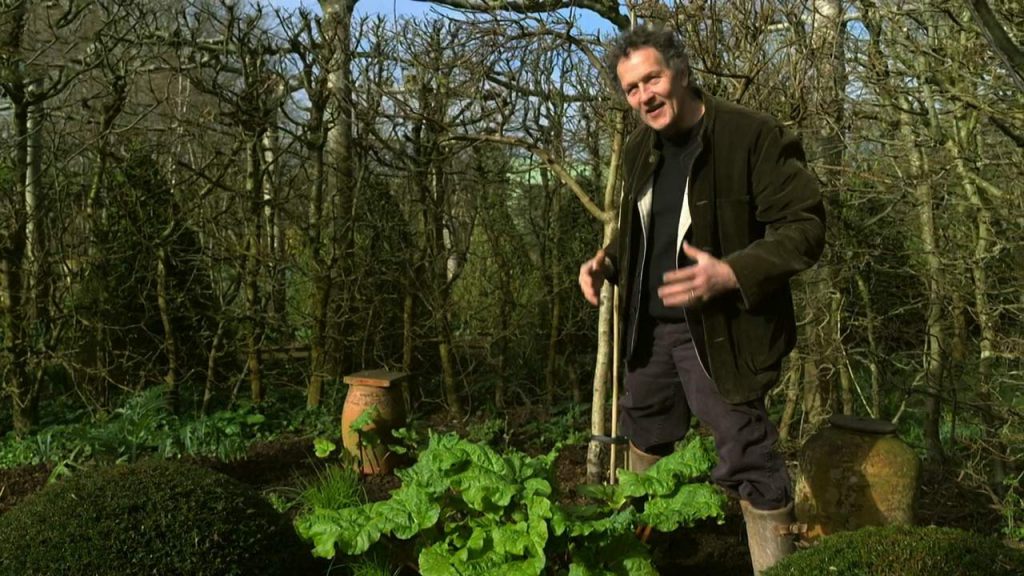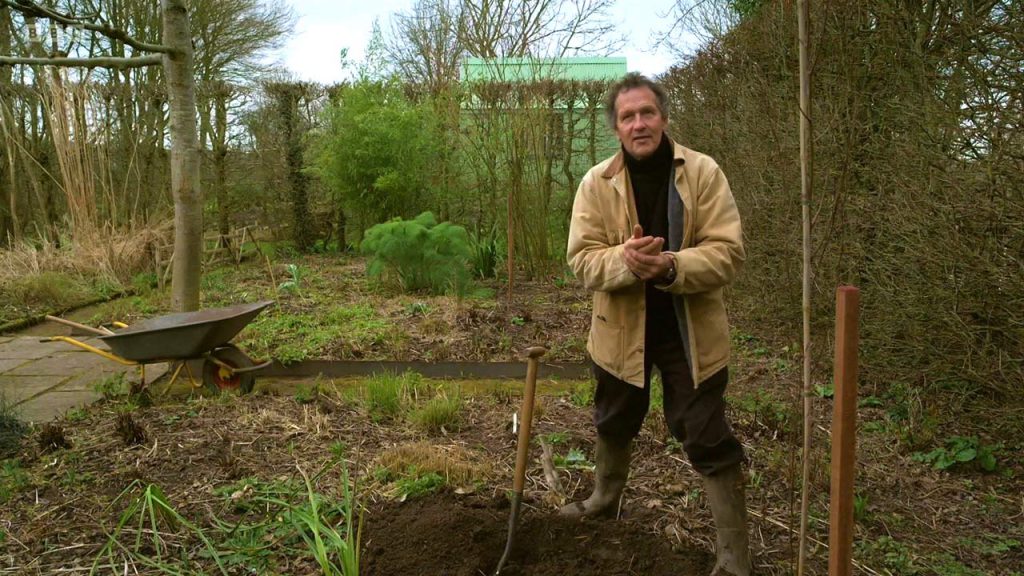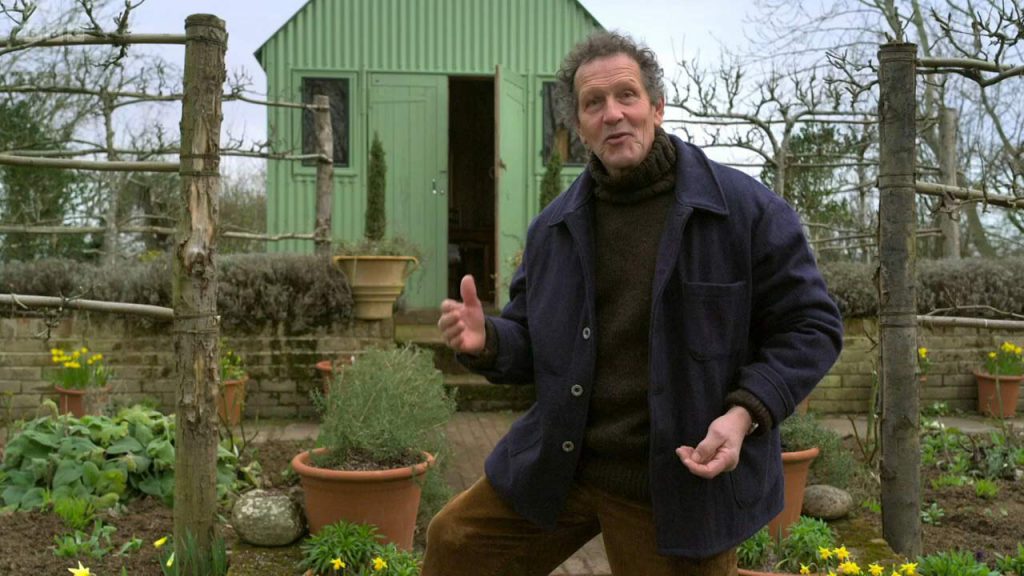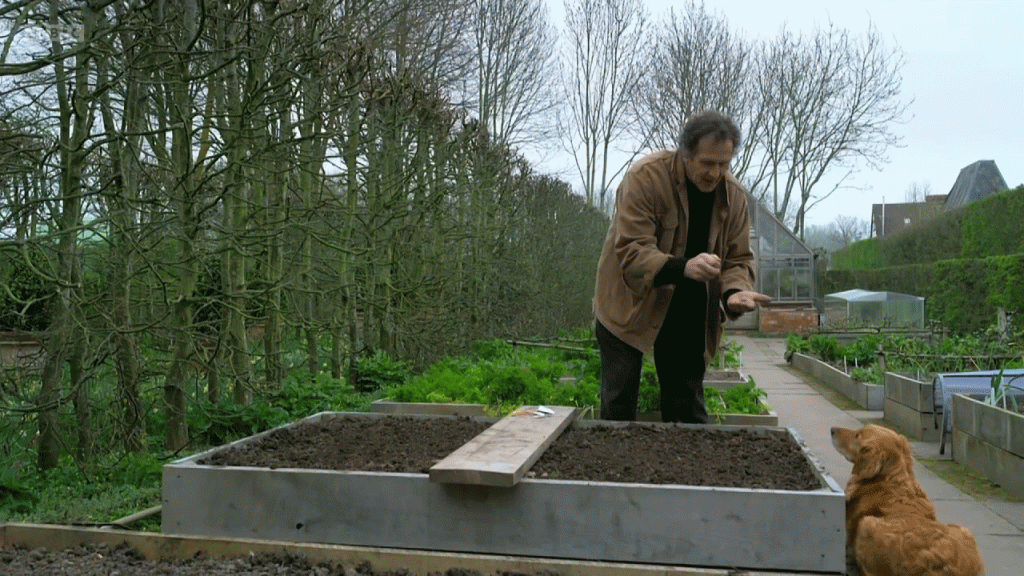Gardeners’ World 2022 episode 3: Monty gets stuck into some seasonal jobs at Longmeadow. Nick Bailey heads to Bodnant Garden in north Wales to find out how the team are tackling the recent storm damage and what new planting opportunities have been created. Frances Tophill meets a couple new to gardening who have created a garden that is both productive and ornamental in a long, narrow plot at their home in Somerset.
GP Amir Khan shares the health benefits of gardening and spending time in green spaces at his wildlife friendly garden in Leeds. In Lincolnshire, meanwhile, we visit a grower who champions the hollyhock, as custodian of the national collection of this cottage garden favourite. Viewers also share what they’ve been up to in their gardens.
Gardeners’ World 2022 episode 3
Rhubarb
Rhubarb is a rhizomatous perennial whose leafstalks (technically leaf petioles but often referred to as ‘sticks’ or ‘stems’) are grown as a vegetable but used mainly as a dessert. It crops over a long period, is completely hardy and grows in any garden soil.
Any fertile garden soil can be used for rhubarb, as long as it is well drained and in full sun. Crowns (‘sets’) can be cropped for ten or more years, though division may be necessary after about five years. Although the large foliage can help smother weeds, the ground should be free from perennial weeds before planting. Dig in one to two bucketfuls of well-rotted organic matter, such as manure, before planting. Plant crowns in November or December. If necessary, planting can continue up to the beginning of March. Buy named cultivars, or choose a division from a strong, healthy-looking plant.
In hot summers, if the ground becomes dry, growth will slow down and even stop. A spring mulch of well-rotted organic matter 7cm (2½in) deep will help to retain moisture, but do not bury the crowns. Plants will also respond to watering during prolonged dry periods in summer. Apply a general fertiliser such as Growmore in spring or summer at 70g per sq m (2oz per square yard).
Allow the foliage to die back naturally in autumn, then cut away the old leaves to expose the growing points to winter cold. There is no harm in adding these leaves to the compost heap, as the poisonous oxalic acid contained in them breaks down during decomposition. Rhubarb requires seven to nine weeks of cold weather below 3ºC (37ºF), depending on the cultivar.
Salad leaves – Gardeners’ World 2022 episode 3
It’s so quick and easy to grow your own salad leaves, even those exotic ones you see in the supermarket. These are cut-and-come-again crops – regularly cut a few leaves from each plant and more re-grow. The most popular crop is lettuce, but there are many other delicious choices, including chicory, endive, sorrel, spinach, mizuna, mibuna, rocket and mustard.
Grow salad leaves in full sun and well-drained conditions. They’re ideal in containers and growing bags, but also grow well in a veg plot or even just a handy gap at the front of a border. Sow indoors in small pots or modular trays from February. Sow outdoors from mid-spring through to late summer, at a depth of 1cm (½in), scattering the seeds thinly. You can either sow different types in individual rows or pots, or simply sprinkle a salad-leaf seed mix on a patch of bare soil or a compost-filled container, then cover with 1cm (½in) of compost. As the seedlings grow, thin out a few to prevent overcrowding. This gives the remaining plants more room to develop, and you can use the thinned seedlings in salads.
You should get three or four harvests from one sowing, so the secret to having salad leaves all summer is to sow several small batches, about a fortnight apart. Then once one batch is finished, you can start the next.
How to grow hollyhocks
Hollyhocks are easy to grow and their blooms come in a wide range of jewel colours, flowering from early summer to autumn. Their tall spires look good grown against walls and fences and are stalwarts of cottage gardens. Hollyhocks can be cut for bouquets and you can even add the petals to salads or crystallise for cake decorations.
Hollyhocks will grow in any garden soil, but prefer fertile, well-drained soil, in full sun, to produce the tallest flower spikes. Choose a position that is sheltered from strong winds, else they tend to blow over. Plug plants, bought in garden centres or online, are best grown on in 10cm (4in) pots to establish a good root system, before planting out into the garden.
If growing hollyhocks from seed sow indoors in mid- to late spring or directly in the position you want them to grow in May/June (See the Propagation section below for more details).
Discovering the Joys of Gardening: Insights from Gardeners’ World 2022 episode 3
Seasonal Gardening Jobs at Longmeadow
In the heart of Longmeadow, Monty Don engages in a series of seasonal gardening tasks, embodying the spirit of Gardeners’ World. These tasks range from essential garden maintenance to creative landscaping, providing viewers with invaluable insights into maintaining a vibrant garden throughout the year. This section explores the essence of Monty Don’s approach to gardening, emphasizing the importance of timing and technique in various gardening jobs.
A Deep Dive into Longmeadow’s Gardening Techniques
Under Monty Don’s guidance, we learn the art of balancing aesthetic appeal with practical gardening. This involves an in-depth look at soil preparation, plant selection, and the maintenance of diverse garden sections, each with its unique charm and requirements.
Nick Bailey’s Visit to Bodnant Garden
Gardeners’ World 2022 also takes us to the magnificent Bodnant Garden in North Wales, where Nick Bailey explores the aftermath of storm damage and the emergence of new planting opportunities. This visit highlights the resilience of nature and the adaptive strategies of gardeners in the face of environmental challenges.
Bodnant Garden: A Case Study in Garden Recovery
Delving into the recovery strategies employed at Bodnant Garden, we discuss how the garden’s team navigates storm damage, focusing on innovative planting techniques and the rejuvenation of the garden’s landscape.
Ornamental and Productive Garden Design
Frances Tophill introduces us to a couple in Somerset who have masterfully blended ornamental and productive elements in their garden. This section provides detailed insights into creating a garden that is both aesthetically pleasing and yields bountiful harvests.
Balancing Beauty and Bounty
We explore the key elements of designing a garden that harmonizes ornamental beauty with agricultural productivity. Practical tips on plant selection, layout designs, and maintenance routines are provided to help readers create their own dual-purpose gardens.
Frequently Asked Questions – Gardeners’ World 2022 episode 3
What are some key seasonal jobs for maintaining a garden?
Seasonal jobs include soil preparation, planting, pruning, and dealing with pests and diseases.
How can one design a garden that is both ornamental and productive?
By carefully selecting plants that are both aesthetically pleasing and edible, and planning the layout to serve both purposes.
What gardening techniques are highlighted in Gardeners’ World 2022?
Techniques such as soil enrichment, innovative planting strategies, and recovery from environmental damages are featured.
Can you provide tips for a beginner in gardening?
Start small, focus on soil health, choose easy-to-grow plants, and be consistent in your gardening routine.
What makes Bodnant Garden unique?
Its resilience to environmental challenges and the innovative strategies employed for garden recovery and rejuvenation.
In conclusion, Gardeners’ World 2022 serves as a beacon of inspiration and practical guidance for garden enthusiasts. From the serene tasks at Longmeadow to the resilient strategies at Bodnant Garden, each episode is a treasure trove of knowledge and beauty, encouraging us to explore the limitless possibilities of gardening.




